
Bloomfield is a city in Davis County, Iowa, United States. The population was 2,682 at the 2020 census. It is the county seat of Davis County.
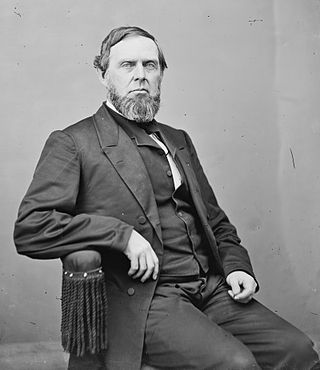
James Harlan was an attorney and politician, a member of the United States Senate, a U.S. Cabinet Secretary at the United States Department of Interior under President Andrew Johnson, and a Federal Judge.
Luther College is a private Lutheran liberal arts college in Decorah, Iowa. Established as a Lutheran seminary in 1861 by Norwegian immigrants, the school today is an institution of the Evangelical Lutheran Church in America. The upper campus was listed as the Luther College Campus Historic District on the National Register of Historic Places in 2021.

The Martin Luther King Jr. National Historical Park covers about 35 acres (0.14 km2) and includes several sites in Atlanta, Georgia related to the life and work of civil rights leader Martin Luther King Jr. Within the park is his boyhood home, and Ebenezer Baptist Church — the church where King was baptized and both he and his father, Martin Luther King Sr., were pastors — as well as, the grave site of King, Jr., and his wife, civil rights activist Coretta Scott King.
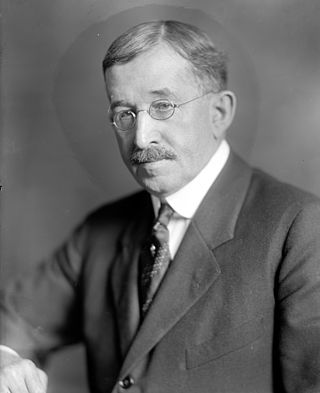
Edward Everett Holland was an American lawyer, banker, and politician who served as a U.S. Representative from Virginia from 1911 to 1921.
Temple House may refer to:

The Prospect Park Historic District in Davenport, Iowa, United States, is a historic district that was listed on the National Register of Historic Places in 1984. In its 23.2-acre (9.4 ha) area, it included 23 contributing buildings in 1984. The Prospect Park hill was listed on the Davenport Register of Historic Properties in 1993.

The Abner Davison House, also known as Riverview, is one of several mansions that overlook the Mississippi River on the east side of Davenport, Iowa, United States. It has been listed on the National Register of Historic Places since 1984, and on the Davenport Register of Historic Properties since 1997.

The Hiram Price/Henry Vollmer House is a historic building located on the Brady Street Hill in Davenport, Iowa, United States. It was listed on the National Register of Historic Places in 1983. The home is named for two members of the United States House of Representatives who lived in the house, Hiram Price and Henry Vollmer, who both represented Iowa's 2nd congressional district. The building is now a part of the campus of Palmer College of Chiropractic where it houses the Office of Strategic Development.
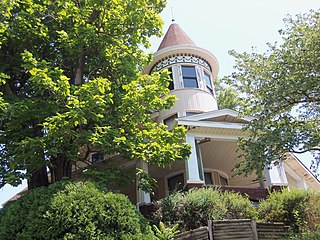
The Lewis M. Fisher House is a historic building located on the east side of Davenport, Iowa, United States. It has been listed on the National Register of Historic Places since 1983.
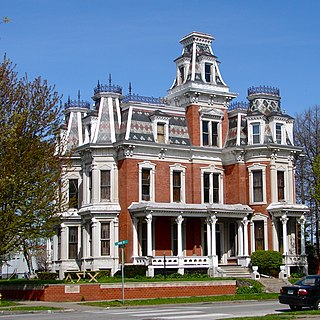
The J. Monroe Parker–Ficke House is a historic building located in the College Square Historic District in Davenport, Iowa, United States. The district was added to the National Register of Historic Places in 1983. The house was individually listed on the Davenport Register of Historic Properties in 2003.

Herndon Hall, also known as the Bergmann Mansion, is an historical residential building located in Des Moines, Iowa, United States. The house was built in 1881 in the Queen Anne style. It was designed by the Des Moines architectural firm of Foster & Liebbe for attorney Jefferson Polk. He named the house after his wife, Julia Herndon. Over the years it has been the home of three bishops of the Diocese of Des Moines, a clothing store, and it served as the National Headquarters for Better Homes & Gardens Real Estate Service. It now houses a cosmetic & reconstructive surgery practice It was listed on the National Register of Historic Places in 1977.
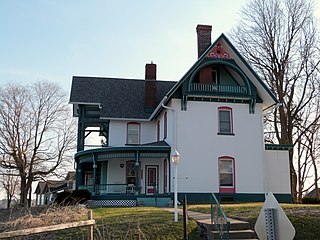
The Jagger–Churchill House is a historic building located in Burlington, Iowa, United States. It was listed on the National Register of Historic Places in 1982. This house is representative of those built by Burlington's wealthier citizens when the city was one of Iowa's major commercial centers in the late 19th and early 20th centuries. Erasmus D. Jaggar, who had the house built, ran a successful linseed oil business. He and his wife Julia raised their five children here. Francis and Catherine W. Churchill bought the house from the Jaggar heirs in 1889. He founded the Churchill Drug Company, which became one of the largest wholesale drug firms in the Midwest by the time of his death in 1896. The house remained in the Churchill family until 1935. The structure does not exhibit any one architectural style, but is a combination of elements of the Gothic Revival, Italianate, Queen Anne, and Eastlake styles.
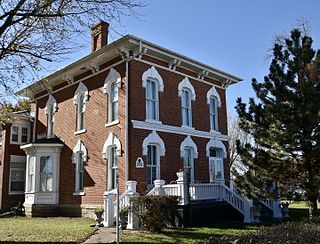
The Elbert-Bates House is a historical residence located in Albia, Iowa, United States. The house is named for two of its earlier owners. Benjamin F. Elbert was a cashier and member of the board of directors of the First National Bank of Albia, as well as a cattle farmer. He relocated to Des Moines, where he was a successful businessman. David W. Bates was a local attorney and banker. He served as the Iowa State Superintendent of Banking during the Great Depression. Elbert had the original house built from 1873 to 1875. Bates had the two-story Prairie Style-influenced solarium built onto the rear of the house from 1917 to 1918. The house originally had a wooden porch on the front, but, because of extensive wood rot, it was removed at the same time the solarium was added.
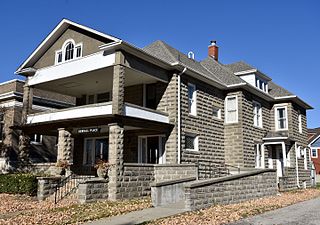
The Noble-Kendall House, also known as Kendall Place, is a historical residence located in Albia, Iowa, United States. Alvis E. Noble was a local businessman and contractor who operated a concrete block factory. He and his wife Cordelia had this house built after their previous house was destroyed in a fire. Completed in 1907, it was built with concrete block, which was an unusual building material for residential construction at the time.

Porter Hall is a historic residence located in Centerville, Iowa, United States. The 2½-story frame house exhibits aspects of the Picturesque Tudor Revival style, especially in the half-timbering and stucco. The house gained its present appearance during the ownership of Dr. Charles James in the 1910s and 1920s. There is some question as to whether this is an older 1880s house that has been extensively remodeled. It receives its name from Claude R. Porter who owned this property from 1906 to 1909. Porter was a Democrat, who served two terms in the Iowa House of Representatives, two terms in the Iowa Senate, United States Attorney for the Southern District of Iowa, and a member of the Interstate Commerce Commission. He was also a perennial candidate for Governor of Iowa and the U.S. Senate from Iowa, but lost every election to his Republican opponent. The house was listed on the National Register of Historic Places in 1980.

The Perrigo-Holmes House is a historic residence located in Boone, Iowa, United States. Joel C. Perrigo was a Vermont native who worked for several different railroads, including the Chicago and North Western, which probably brought him to Boone. He also had extensive land holdings in the county. Adoniram J. Holmes was a local attorney who was elected the mayor of Boone before being elected to the United States House of Representatives as a Republican. He represented Iowa's 10th congressional district before serving as the Sergeant at Arms of the United States House of Representatives. He and his wife Emma bought the house right after he was elected to congress. Perrigo had the two-story, frame high-style Italianate house built around 1871. The "L" shaped structure features paired brackets under the eaves, and the front porch is located in the inside angle. A barn, believed to be a contemporary of the house, is also part of historic listing. It is one of a few town barns left in Boone. The house was listed on the National Register of Historic Places in 1994.

The Wells-Stubbs House is a historic residence located in Fairfield, Iowa, United States. This house was built for George and Priscilla Wells in 1874. Its notoriety is derived from the residency of Daniel P. Stubbs, who lived here from 1877 to 1905. Stubbs was a leader in the Greenback Party in Iowa, and he served as their candidate for state and national offices. Early in his law career he was a partner with future congressman and Senator from Iowa, James F. Wilson. Stubbs was a successful defense attorney, as well as an attorney for the railroads. While still a Republican, he was elected mayor of Fairfield and to the Iowa Senate. He did not hold office as a Greenbacker.
The Francis A. and Rose M. Turner House is a historic building located in Avoca, Iowa, United States. Turner was born in Des Moines County, Iowa, and the family moved to Pottawattamie County the following year where they farmed. After spending a period of time teaching, he studied law and settled in Avoca after passing the bar. Rose M. Woodward was a local school teacher. Their grandson Richard, also an attorney, entered politics and became Iowa's Attorney General and the U.S. Attorney for the Southern District of Iowa. This two-story frame Neoclassical house was built in 1905, probably by local builder Fred Thiessen. After Francis' death in 1935 the house passed to their son Joe and his wife Elizabeth. It was listed on the National Register of Historic Places in 1997.

The Jackson–Swisher House and Carriage House, also known as the Old Swisher Place, is a historic building located in Iowa City, Iowa, United States. Louis H. Jackson, who built the house, was a local attorney until he relocated to Denver, Colorado. Stephen A. Swisher, who lived here for 40 years, started an insurance agency and served as a curator and president of the State Historical Society of Iowa. Both were graduates of the University of Iowa. The house's primary significance is architectural, and it is said to have "more characteristics of the Gothic Revival than any other house in Iowa City." The steeply pitched cross gable roof is set off by bargeboards with quatrefoil and circular openings. The paired windows of various designs, the window bays, the dormer-like window above the main entrance, and the fluted chimneys lend a picturesque quality. The front porch features tracery ornamentation. The former carriage house, converted into a garage in 1946, is simpler in its ornamentation. It has paired windows on the second floor, and like the main house, there is a gentle flair at the eaves. The buildings were listed together on the National Register of Historic Places in 1982.



















